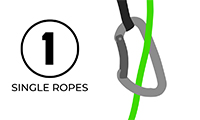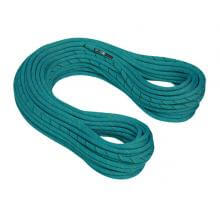10.0mm Sensor 60m Bipattern Dry
Description
An absolute world first – the 10.0 Sensor is the first rope with both visual and sensible markings. These markings allow both belayer and climber to see and feel that they are coming close to the end or middle of the rope. The BiCo Sense technology is therefore an important safety feature, since it allows the belayer looking up to the climber to be aware when he or she is paying out rope beyond the middle or is reaching the end of the rope when lowering the climber. This feature will be particularly appreciated by gym climbers and sport climbers. The 10.0 Sensor is also equipped with the superDRY™ finish, giving the rope long-lasting resistance to dirt and water.
BiCo Sense technology
The world's first rope with visual and haptic markings on the end and in the middle
Haptic markings help to improve safety when belaying and releasing
Retail price
This Product is Hard to Find.
We don’t know where you can buy this item online in the US. We’ll continue to check all the major retailers and will update this page as soon as we find one.
If you know where to find this online in the US, let us know, and we’ll add the link.

| Weight | 67.0 g/m 8.862 lbs / 4020 g |
| Diameter (millimeters) | 10.0 mm |
| Length (meters) | 60 m |
Rope Type  Type
There are 3 types of dynamic ropes that are used by climbers. They are known as Single, Half (Double), and Twin. The type of rope preferred varies by climbing style, location, and region. Single
By far, the most common type of rope. Great for indoors and out. In the US, it is the most common sport and big wall and are also used for trad cragging. The handling is simple and the diameter options are quite varied. Half (Double)
The best cure for a meandering route, only one of the ropes will clip into each piece of protection so a mindful climber can can reduce rope drag considerably. You can also rappel twice the distance, it’s easier to safely protect traverse pitches and there is a smaller chance that both ropes would become damaged (by rockfall, crampons, etc). Twin
Both ropes must be clipped through each piece of protection. This is the lightest style of (two) ropes. They excel for rappels, going twice the distance vs a single rope, but do not have the ability to mitigate rope drag even though there are two ropes. It is unlikely both ropes will be damaged at once, and is why many alpine, ice and mixed climbers choose twin and/or half ropes. Learn More
Every rope type and when to use them | Single |
UIAA Falls (Single / Half / Twin)  UIAA FallsThis refers to the number of UIAA falls a rope has been tested to be able to withstand without breaking. The UIAA fall is a complicated test that is designed to create a uniform standard for strength in ropes, and is not generally reflective of real-world climbing situations. The test involves dropping a weight tied to the rope in such a way that it will see the highest amount of force a real-world situation could generate. The UIAA requires that Single and Half ropes must pass this test without breaking at least 5 times, while twin ropes must withstand 12 falls. In practice, it can likely be concluded that ropes that have higher than this standard number of falls will be stronger and put up with more abuse. It is important to note that any rope that is UIAA or EN certified is considered safe to climb on, regardless of the number of UIAA falls it is rated for. | 9 falls / - / - |
Dynamic Elongation (Single / Half / Twin)  Dynamic ElongationThis refers to the amount of stretch measured during the dynamic testing (or drop test) used when certifying ropes. Higher stretch will absorb more force and result in a softer catch but increases chances of groundfall at the beginning of a climb. The EN and UIAA require a stretch of at least 10% and no more than 40% for dynamic ropes. Single and Half ropes are tested individually and Twin ropes are tested as a pair. | 30.0 % / - / - |
Static Elongation (Single / Half / Twin)  Static ElongationThis refers to the amount of stretch measured during the static test used when certifying ropes. Most climbers will notice the difference in static elongation when climbing in a top rope situation, where higher stretch will make for a springier belay and could result in a ground fall when climbing closer to the ground. The EN and UIAA require a stretch of no more than 10% for Single and Twin ropes and no more than 12% for Half ropes. Single and Half ropes are tested individually and Twin ropes are tested as a pair. | 8.5 % / - / - |
Impact Force (Single / Half / Twin)  Impact ForceImpact force is the amount of force in kN that is measured at the testing mass during the UIAA dynamic drop rope test. When the weight is dropped, the force measured must be at or below 12kN for Single and Twin ropes and 8kN for Half ropes. The real world application of this test is determining that the rope can dissipate and absorb the appropriate amount of force from the fall as it would be felt by the climber. The variables used in the test set a situation that is well beyond anything climbers encounter, and shouldn't be considered realistic to actual climbing situations. In reality forces of this magnitude would result in severe injury as this test is designed to test the limits of the rope and not the comfort of the climber. | 8.90 kN / - / - |
Dry Treatment  Dry TreatmentWhen a rope is dry treated, it has had a coating applied to its core fibers, its sheath fibers, or both. The purpose of this coating is to reduce the amount of water the rope can absorb when in wet or icy conditions. Wet ropes are heavier, handle and belay differently, and have been tested to be weaker than dry ropes. Many climbers prefer dry treated ropes for very dusty or dirty environments, as they are more resistant to uptake of dirt and can stay cleaner longer. Learn More
Benefits of Dry vs Non-Dry ropes | Sheath only |
| Sheath Proportion (%) | 38.0 % |
| Sheath Slippage (mm) | 0 mm |
| Type of Middle Mark | Bipattern |
| Rope End Marker | Yes |
| Certification | CE, EN, UIAA |
RFID / NFC Option  RFID and NCFThis technology can be helpful if you are a gym or professional business where you'd like to track the usage and age of your ropes. RFID is how items are uniquely identified using radio waves (Radio Frequency Identification). It's for 1-way communication from 10cm to 100m away depending on the frequency. Example: Airport Baggage. NFC is a subset of RFID that is restrained to close proximity communication typically less than 10cm (Near Field Communication). NFC chips can operate a 2-way signal to exchange information. Example: Apple Pay. | None |
No reviews yet.
With the introduction of the visual and sensible markings on the Sensor, we have seen the first significant improvement in climbing rope safety in some time. In this initial offering there are still performance and price issues, but with time we expect Mammut to resolve them. Until this technology becomes available in more models, this rope is ideal for climbers shopping for a workhorse rope that are also interested in increasing their margin of safety.
This workhorse rope has a surprisingly simple but effective system for alerting the user when he is reaching the middle or the ends, and its continued high-level performance after a year of use speaks to its durability.
The rope is also marked with a bi-pattern, half of the rope has a subtle yellow marking in its sheath, and the other half is marked red. All in all, this rope is more clearly marked for its middle and ends than any other cord I’ve used.
Like most of the Mammut ropes I’ve had the Sensor has held up well. The BioCo Sense is what makes it stand apart. Hopefully Mammut can figure out a way to get the price down, over $300 is a big chunk of change to throw down on a rope, but nonetheless this rope has some technology that is super useful for proper and safe rope usage.
This video shows all the features of Mammut ropes.





